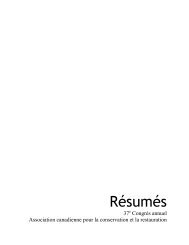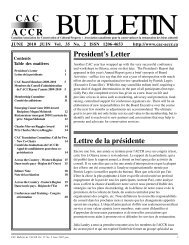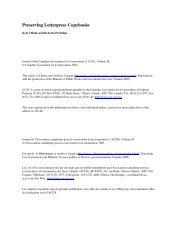Ottawa - Canadian Association for Conservation
Ottawa - Canadian Association for Conservation
Ottawa - Canadian Association for Conservation
Create successful ePaper yourself
Turn your PDF publications into a flip-book with our unique Google optimized e-Paper software.
The Auto-fluorescence of Asian Lacquer<br />
Marianne Webb, Senior Conservator, Decorative Arts<br />
Royal Ontario Museum, Toronto ON<br />
For several years conservators have noticed that Asian lacquer sometimes appears to fluoresce under<br />
ultraviolet light. This study was undertaken to determine the circumstances of auto-fluorescence of<br />
Asian lacquer. To begin, dozens of lacquer objects from the Royal Ontario Museum and the author’s<br />
collection were examined. They all appeared to fluoresce. New sample boards were made and also<br />
examined, which also fluoresced. It was determined that Asian lacquer always fluoresces, ranging in<br />
colour from orange to muddy yellow, although due to the weak fluorescence of many objects it is not<br />
always readily apparent. Several factors play an important role in observing the florescence, such as<br />
quenching, ultraviolet lamp quality and the room environment.<br />
Conservators studying lacquer observed that Asian lacquer fluorescence appears to increase<br />
in intensity when the surface of the object has been previously damaged by exposure to light.<br />
Experiments conducted on both fresh and aged samples of different types of lacquer demonstrate this<br />
to be true. Asian lacquer exhibits a marked increase in fluorescence as well as a shift in colour from<br />
orange toward yellow when exposed to UV and visible light <strong>for</strong> an extended period of time.<br />
How is this knowledge useful to conservators? Experience has shown us that the degradation<br />
products <strong>for</strong>med during light exposure are soluble in polar solvents. In fact this is why it is difficult<br />
to safely clean lacquer without removing the top water soluble layer and possibly the decoration<br />
along with it. It has been suggested that the increase in fluorescence could be a guide to cleaning,<br />
as the fluorescence should return to its original state if the degradation products were removed.<br />
Experiments were conducted on 12 objects with severe light damage. After cleaning with water, some<br />
objects increased in fluorescence, some decreased and some remained the same. This indicates it is not<br />
a good guide to surface changes during cleaning.<br />
Although our knowledge of the chemistry of Asian lacquer auto-fluorescence is limited at the<br />
moment, the phenomena can still be of some use in treatment. Because fluorescence increases with<br />
light degradation, the colour and intensity observed can be used as a tool to determine the state of the<br />
surface. When identifying Asian lacquer, it can be used to eliminate some look-alike materials and to<br />
distinguish pigments. It is also useful to determine the treatment history of the object since objects<br />
recoated with urushi or western varnishes are readily apparent.





